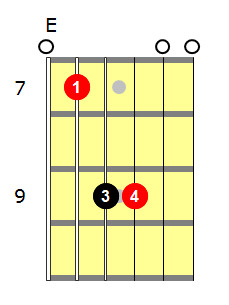Welcome to day 4. Today you’re going to learn one of my all time favourite chords.
This is a very different way to play an E chord, and once you’ve learnt it, you’ll never play an E chord the same way again.
I play a lot of acoustic music – both at church and at home – and this chord shape is used a lot!
You’re probably used to playing an E chord as a barre chord on the 7th fret using the basic ‘A’ chord shape.
This chord takes that basic position, but changes it.
Look at the bottom two strings – you’re playing the open E on the low E string, and fretting another E an octave higher on the A string on the 7th fret. Straight away, this makes the bottom end of the chord sound fatter. It’s a trick that guys like Hendrix used to do.
Next, take a look at the top two strings. In a normal E barre chord, you’d barre your first finger across the 7th fret. In this chord there’s no barre, and the top two strings are played open.
This adds a high E to the chord as well as a ‘B’ note. Instead of playing a G# note on the B string at the 9th fret, you’re playing the string open.
The other thing that’s different about this chord is that it only has the 1st and 5th in it – there’s no 3rd.
Without going too deep into chord theory – usually a chord has three notes. A mojor chord has the 1st, 3rd and 5th. The 3rd is a weaker tone, the 1st and 5th stronger tones.
In this chord you’ve got rid of the 3rd (weaker tone) and replaced it with another 5th (stronger tone).
Now, here’s where it gets interesting and you get some bonus chords (And get to sound great as a bonus!!!).
The extra special bonus chords!!
You can move this E shape up and down the fretboard to turn it into different chords. I show you this in the video. If you do this, don’t play the bottom E – mute that string.
If you play the shape with the root on the 2nd fret, it turns into a B chord.
On the 4th fret, it’s an awesone C#m chord.
It also sounds ok on the 5th fret as a D chord, and on the 10th fret as a G chord. I’ve also played it up on the 12th fret as an A chord.
Have a look in the video below to see how I do it.
Once you understand how this chord works, you’ll use it a lot in the key of E.
That’s it for today’s lesson. Hope you’ve enjoyed it. Keep practicing and I’ll see you again tomorrow.
